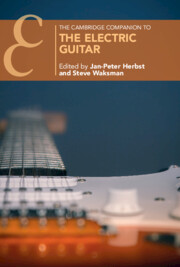Book contents
- The Cambridge Companion to the Electric Guitar
- Cambridge Companions to Music
- The Cambridge Companion to the Electric Guitar
- Copyright page
- Contents
- Figures
- Tables
- Contributors
- 1 Introduction
- Part I History
- Personal Take I: Michael Astley-Brown
- 2 The Misunderstood History and Prehistory of the Electric Guitar
- 3 The Electric Guitar’s “Golden Age”
- 4 The Guitar Hero in Classic Rock
- Part II Technology and Timbre
- Part III Musical Style and Technique
- Part IV The Electric Guitar in Society
- Part V The Global Instrument
- Index
- References
3 - The Electric Guitar’s “Golden Age”
from Part I - History
Published online by Cambridge University Press: 08 November 2024
- The Cambridge Companion to the Electric Guitar
- Cambridge Companions to Music
- The Cambridge Companion to the Electric Guitar
- Copyright page
- Contents
- Figures
- Tables
- Contributors
- 1 Introduction
- Part I History
- Personal Take I: Michael Astley-Brown
- 2 The Misunderstood History and Prehistory of the Electric Guitar
- 3 The Electric Guitar’s “Golden Age”
- 4 The Guitar Hero in Classic Rock
- Part II Technology and Timbre
- Part III Musical Style and Technique
- Part IV The Electric Guitar in Society
- Part V The Global Instrument
- Index
- References
Summary
The release of the Fender Telecaster, Gibson Les Paul, and Fender Stratocaster in the early 1950s has led that era to assume the status of a “golden age” of electric guitar design and production. This chapter seeks to broaden the terms according to which we understand this pivotal moment through multiple lenses. First, it documents an earlier turning point in electric guitar history in the mid to late 1930s, when the Spanish-body electric ascended to prominence over its Hawaiian-style counterpart. Next, it examines the prehistory of the commercial solid body through the preproduction prototypes built by Les Paul, Leo Fender, and Paul Bigsby. Third, the chapter highlights the continued importance of hollow body electrics throughout the 1950s, in conjunction with the early years of rock ‘n’ roll. Lastly, it foregrounds the impact of low-cost electric guitars produced by companies such as Harmony and Kay, which helped make the instrument into a more accessible commodity.
Keywords
- Type
- Chapter
- Information
- The Cambridge Companion to the Electric Guitar , pp. 36 - 52Publisher: Cambridge University PressPrint publication year: 2024

